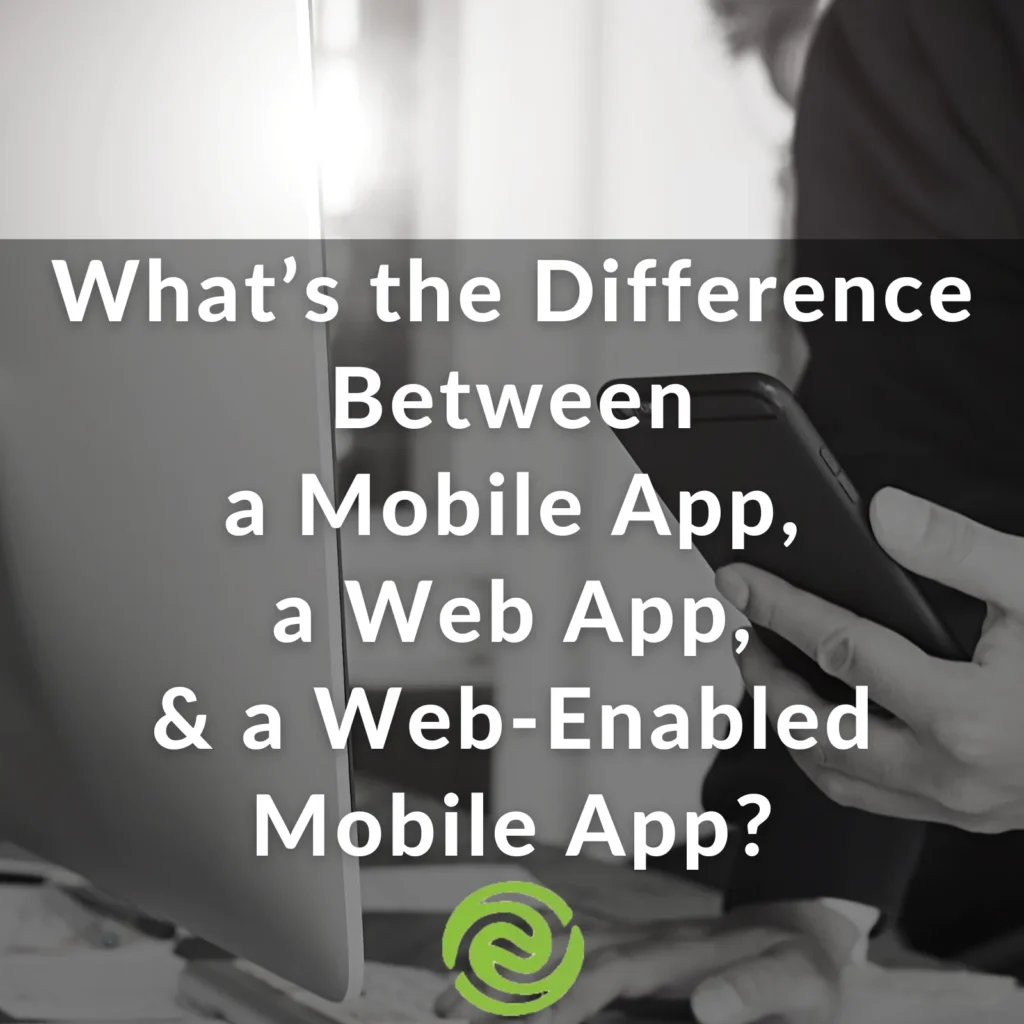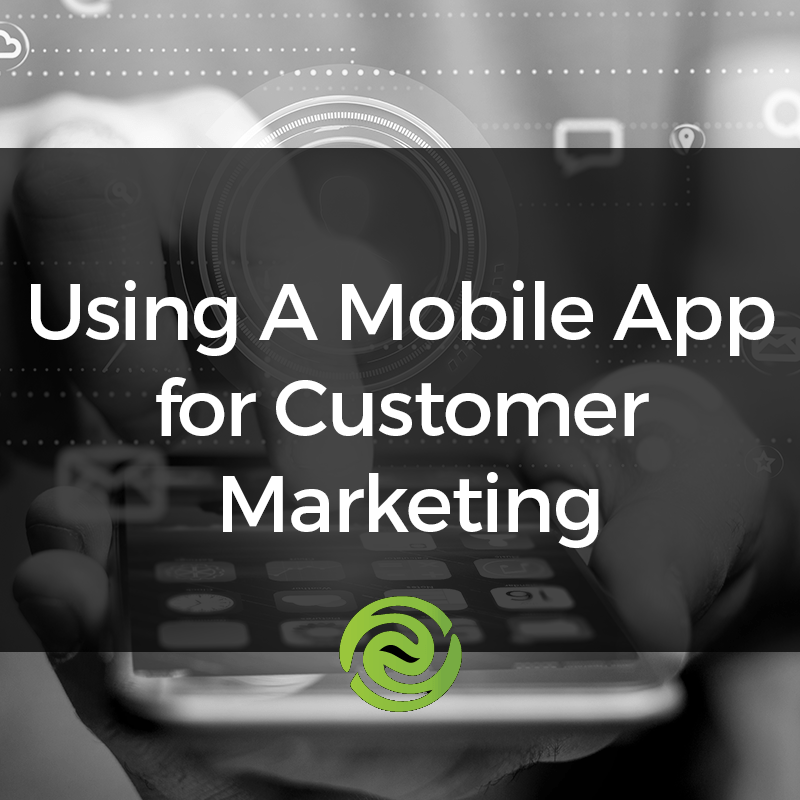Do you feel like you’ve tried everything to ramp up B2B leads without getting the…
What’s The Difference Between a Mobile App, a Web App, and a Web-enabled Mobile App?

In the digital age, the distinction between mobile apps, web apps, and web-enabled mobile apps can be nuanced yet crucial for businesses and developers alike. Before you embark on your digital transformation, take a few minutes to dig into the benefits and challenges associated with each of these application types. The first thing to understand is each solution outlined below caters to distinct strategic goals, target audiences, and operational efficiencies. Understanding the motivations behind choosing one over the others can illuminate the path to a more engaging user experience and a more effective digital presence.
As we navigate through these definitions, our objective is to demystify the technical jargon and present a clear understanding suitable for decision-makers at all levels.
What is a mobile app?

Mobile applications are software applications developed specifically for mobile devices utilizing platform-specific programming languages. These applications are designed to run on mobile operating systems such as Apple iOS and Android and are available through app distribution platforms like the Apple App Store, Google Play Store, and other app deployment mechanisms. These apps are referred to as native apps. Native apps ensure optimal performance on the device they are designed for and provide the ability to take full advantage of the device’s features. Now, let’s break down the advantages and challenges associated with mobile app development.
Advantages
Write Once Use Many: Some mobile app languages allow you to write one set of code for multiple platforms, with only minor interface tweaks needed between platforms.
Enhanced User Experience: Mobile apps provide a seamless, intuitive user interface, optimized for the device’s hardware. This leads to higher user engagement and satisfaction.
Offline Access: For services requiring availability without constant internet access, mobile apps can store data locally and sync once a connection is re-established.
Utilization of Device Features: Mobile apps can leverage device capabilities such as the camera and GPS to enhance functionality and user interaction.
Brand Presence: Having an app on a user’s device increases brand visibility and can facilitate more personalized marketing strategies through push notifications and updates.
Performance and Security: Mobile apps can offer superior performance and the ability to implement robust security measures, crucial for applications handling sensitive user data.
Challenges
Multi-platform Development: Developing applications for multiple mobile platforms (iOS, Android) may involve using different programming languages, which can double the effort, time, and cost.
Limited Screen Size: Mobile devices offer limited real estate, challenging designers to create intuitive, easy-to-navigate interfaces without overcrowding or becoming cumbersome to the user. Balancing aesthetics with functionality is crucial.
Dependence on Network Speed for Data-Intensive Operations: Mobile apps often rely on the internet for data retrieval and operations, making them susceptible to varying network speeds and stability.
What is a web app?

A web application is an app that is written in a specific coding language that the users access using any type of internet browser (ie. Google Chrome, Safari, Microsoft Edge) improving accessibility and usage for a variety of digital savvy audiences. Unlike traditional websites, web apps provide interactive and dynamic user experiences, closely resembling those of mobile applications but within a browser environment.
Advantages
Accessibility and Compatibility: Web apps are accessible from any device with a web browser, ensuring broad reach without the need for multiple platform-specific versions. For example, web applications can look great on any-sized screen from laptops to conference room TVs.
Ease of Maintenance: Updates and bug fixes are implemented server-side, making them immediately available to all users without requiring users to take action and update the app manually.
Cost-Effective Development: Developing a web app can be less resource-intensive than creating native apps for multiple platforms, making it an attractive option for businesses with limited budgets.
SEO and Discoverability: Web apps benefit from search engine indexing, improving visibility and discoverability for new users searching for related services or products.
Quick Deployment: Without the need for app store approval, web apps can be launched and updated more swiftly, allowing businesses to respond rapidly to market changes or user feedback.
Challenges
Contingent Upon Connectivity: Web applications rely on the web browser and underlying internet connection to function, which can introduce variability in performance or render the application useless if internet connectivity is not available..
A Polished User Experience: Due to the wide variety of screen sizes and resolutions, web apps need to be responsive, meaning they automatically adjust their layout and functionality to fit the device they’re being viewed on. Achieving the same level of fluidity and intuitiveness as native mobile apps requires careful design and testing.
Higher Data Usage: Web applications typically fetch resources from the web each time they are accessed, which can lead to higher data usage compared to native apps that request less data and store more resources locally. This is particularly concerning for users with limited data plans on mobile devices or those accessing the web app from areas with spotty or limited internet access.
What is a web-enabled mobile app?

Web-enabled mobile apps blend the accessibility of web applications with the user-centric design of mobile apps. These applications are designed to function effectively on mobile devices while also having the capability of being delivered through a web browser. These apps also circumvents the need for app store approvals and simplifying updates and maintenance.
Advantages
Best of Both Worlds: Combining the user-focused design of mobile apps with the accessibility of web apps, web-enabled mobile apps offer a versatile solution adaptable to both desktop and mobile environments.
Flexibility in Updates: Similar to web apps, these solutions allow for immediate updates across all platforms without user intervention, streamlining the upgrade process.
Avoidance of App Store Limitations: Bypassing the app store submission and approval process accelerates the release cycle and eliminates the constraints and in-app charges imposed by app store policies and processes.
Unified Experience Across Devices: Businesses aiming to provide a consistent user experience across both desktop and mobile platforms may find web-enabled mobile apps to be a good solution.
Cost and Resource Efficiency: Developing a single web-enabled mobile app can be more cost-effective than maintaining separate versions for web and native mobile platforms, particularly for startups and small businesses.
Challenges
User-friendly Design: Achieving a design that feels native to mobile devices can be challenging. Efforts must be focused on ensuring the web-enabled mobile app is not only visually appealing but also intuitive and efficient to navigate on a mobile screen, often necessitating iterative design and testing processes to refine the user experience.
Efficient Data Transfer: Ensuring efficient data transfer, particularly in varying network conditions from high-speed Wi-Fi to limited cellular data connections, is crucial for maintaining the performance and usability of web-enabled mobile apps.
Browser Limitations: Browser limitations pose a significant hurdle in delivering a seamless and fully functional web-enabled mobile app experience. While modern web browsers have grown increasingly capable, discrepancies in support for the latest web standards, APIs, and features across different browsers and versions can restrict what can be achieved.
This may all seem a little confusing, so let’s look at some examples…
Platforms like Instagram and Facebook illustrate the evolution and coexistence of these app types. Facebook, originally a web app, has seamlessly transitioned into the mobile app sphere, whereas Instagram began as a mobile app but has expanded its web application functionalities over time.
Banking applications also provide a clear example, offering both web and mobile app solutions to cater to varying user preferences and needs.

When to use which type of app?
The choice between a mobile app, a web app, or a web-enabled mobile app hinges on understanding your target audience’s preferences, the complexity of the functionalities you wish to provide, and the desired reach of your application. For comprehensive coverage, a combination of web and mobile applications may offer the most thorough user engagement strategy.
- If you are trying to provide easy access to a smaller set of functionality, a mobile app is the perfect fit.
- If you have a larger set of functionality, or it requires a lot of data intensive operations, or you need lots of screen real estate, a web app is the best choice.
- If you only want to build one app that runs on a mobile device and an internet browser, then a web-enabled mobile app is the way to go.
A web application AND a mobile app provide the best overall user experience.
Now that we’ve walked you through the pros and cons of web and mobile application development, you may be wondering how you decide which is best for your business, the work you’re trying to do, and the goals you’re looking to achieve. The good news is that this level of expertise is our sweet spot. We love assisting smart business owners with our combined years in the industry to steer you in the right direction with our signature processes.
The Bottom Line
The bottom line is this… you must keep your audience and their behaviors top of mind throughout the process of moving your technology rocks forward. Perhaps it’s not an ‘either or’ solution, but rather a ‘yes, and’ solution where there is more than one optimal solution to enhance engagement with your brand while improving user experience.
Each application type serves a distinct purpose and caters to specific user needs and business objectives. Clear understanding of your audience’s interaction with your services will inform the direction for expanding your digital footprint. In this decision-making journey, professional guidance tailored to your specific context can illuminate the path to achieving your digital transformation goals. Contact the Swip Systems team to learn more about how our years of experience can help you move your project forward!






